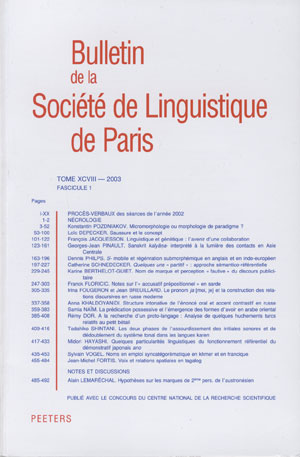 previous article in this issue previous article in this issue | next article in this issue  |

Preview first page |
Document Details : Title: L'harmonie radicale dans les langues d'Afrique Subtitle: De la typologie phonologique à l'effet du déclencheur marqué Author(s): BUROV, Ivaylo Journal: Bulletin de la Société de Linguistique de Paris Volume: 116 Issue: 1 Date: 2021 Pages: 237-279 DOI: 10.2143/BSL.116.1.3290238 Abstract : Cet article se propose d’examiner certains traits phonologiques et typologiques de l’harmonie radicale dans les langues africaines de la ceinture soudanique, lesquels permettent de la considérer comme un phénomène aréal relativement cohérent, indépendant d’autres phénomènes phonétiquement apparentés, mais typologiquement très différents, comme l’harmonie radicale des langues toungouses et mongoles ou l’harmonie de hauteur des langues bantoues. Ces traits concernent la spécificité du geste articulatoire à la base des harmonies [ATR], la directionnalité du processus assimilatoire, les voyelles neutres, le rapport entre la forme de l’inventaire vocalique et les propriétés générales du patron harmonique, etc. L’apport personnel majeur de cet article est de montrer que, tout en possédant ses propres caractéristiques originales, l’harmonie radicale des langues nigéro-congolaises et nilo-sahariennes s’inscrit dans un patron typologique plus général, celui de l’effet du déclencheur faible (ou marqué), qui est un universel phonologique commun à tous les types d’harmonie: vocalique, consonantique, vocalico-consonantique. Découlant de la nature même de l’harmonie vocalique, qui est foncièrement un processus de renforcement, cet effet connaît quatre manifestations différentes dans l’aire linguistique étudiée: premièrement, il détermine la propagation de la valeur marquée de [ATR] dans les systèmes dominants-récessifs; deuxièmement, il est à chercher dans la forte corrélation entre la présence de /ɪ, ʊ/, les voyelles les plus marquées phonétiquement du continuum de F1, et l’existence d’une harmonie radicale; troisièmement, en l’absence d’opposition phonologique entre /i, u/ et /ɪ, ʊ/, l’harmonie est limitée en principe aux seules voyelles moyennes, phonétiquement marquées relativement aux voyelles hautes et basses quant au paramètre de l’aperture; quatrièmement, dans plusieurs langues 1IU, il transparaît de l’inaptitude de /a/, dont la constriction du pharynx est hautement compatible avec son trait [–ATR] inhérent, à harmoniser des voyelles moyennes, cibles potentielles du processus assimilatoire. This paper aims to discuss some phonological and typological features of radical harmony in the African languages of the Sudanic Belt, which allow to consider it a relatively coherent areal phenomenon – independent from other phonetically similar but typologically very different phenomena, such as radical harmony in Mongolic and Tungusic languages or height harmony in Bantu languages. These features concern the specificity of the articulatory gesture underlying [ATR] harmonies, the directionality of the assimilatory process, the neutral vowels, the relation between the shape of the vowel inventory and the general properties of the harmony pattern, etc. The major finding of this paper is to show that, while possessing its own original characteristics, radical harmony of Niger-Congo and Nilo-Saharan languages is part of a more general typological pattern, called Weak or Marked Trigger Effect, which is a phonological universal common to all types of harmony processes: vowel, consonant and vowel-consonant harmonies. Resulting from the very nature of vowel harmony, which is fundamentally a strengthening process, this effect has four different manifestations in the linguistic area under consideration: firstly, it determines the spreading of the marked value of [ATR] in dominant-recessive systems; secondly, it is to be sought in the strong correlation between the presence of /ɪ, ʊ/, the phonetically weakest vowels of the F1 continuum, and the existence of radical harmony; thirdly, in the absence of phonological contrast between /i, u/ and /ɪ, ʊ/, harmony is in principle limited only to mid vowels, which are phonetically marked with respect to high and low vowels for height features; fourthly, in several 1IU languages, it is related to the failure of /a/, whose pharyngeal constriction is highly compatible with its inherent [–ATR] specification, to harmonize mid vowels, which are potential targets of the assimilatory process. |
|


